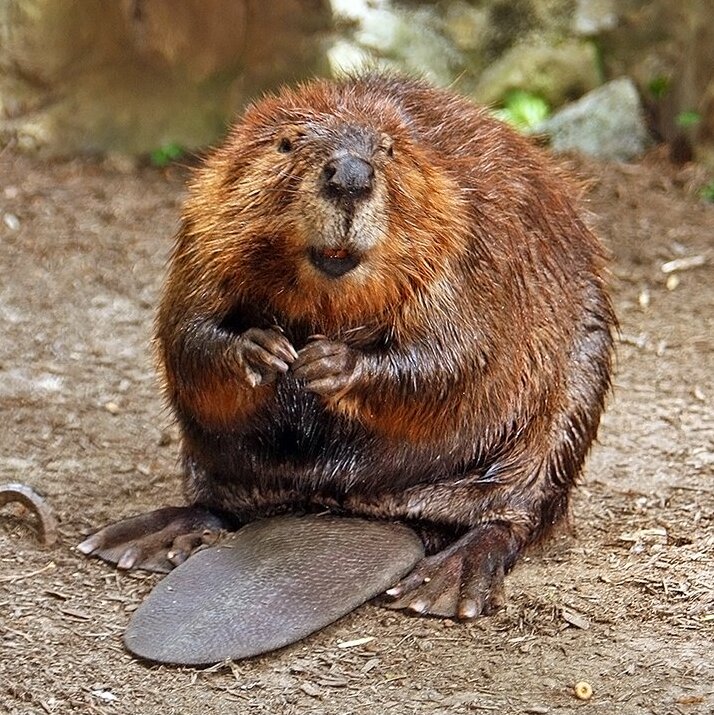Post by dinosauria101 on Oct 16, 2019 16:14:25 GMT 5
Bobcat-Lynx rufus
The bobcat (Lynx rufus) is a North American mammal of the cat family Felidae, appearing during the Irvingtonian stage of around 1.8 million years ago (AEO). With 12 recognized subspecies, it ranges from southern Canada to northern Mexico, including most of the continental United States. The bobcat is an adaptable predator that inhabits wooded areas, as well as semidesert, urban edge, forest edges, and swampland environments. It remains in some of its original range, but local populations are vulnerable to extirpation by coyotes and domestic animals. The bobcat is vital for controlling pest populations. With a gray to brown coat, whiskered face, and black-tufted ears, the bobcat resembles the other species of the mid-sized Lynx genus. It is smaller on average than the Canada lynx, with which it shares parts of its range, but is about twice as large as the domestic cat. It has distinctive black bars on its forelegs and a black-tipped, stubby tail, from which it derives its name. Though the bobcat prefers rabbits and hares, it will hunt anything from insects, chickens, and small rodents to deer. Prey selection depends on location and habitat, season, and abundance. Like most cats, the bobcat is territorial and largely solitary, although with some overlap in home ranges. It uses several methods to mark its territorial boundaries, including claw marks and deposits of urine or feces. The bobcat breeds from winter into spring and has a gestation period of about two months. Although bobcats have been hunted extensively by humans, both for sport and fur, their population has proven resilient though declining in some areas. The elusive predator features in Native American mythology and the folklore of European settlers.

i2.wp.com/digital-photography-school.com/wp-content/uploads/2010/10/dps5_030208_bobcat_lynx_rufus_yosemite_II_520cc.jpg?resize=520%2C376&ssl=1
North American Beaver - Castor canadensis
This beaver is the largest rodent in North America and competes with its Eurasian counterpart, the European beaver, for being the second-largest in the world, both following the South American capybara. Adults usually weigh from 11 to 32 kg (24 to 71 lb), with 20 kg (44 lb) being typical. The head-and-body length is 74–90 cm (29–35 in), with the tail adding a further 20–35 cm (7.9–13.8 in). Very old individuals can exceptionally exceed normal sizes, weighing more than 40 kg (88 lb) or even as much as 50 kg (110 lb).

upload.wikimedia.org/wikipedia/commons/6/6b/American_Beaver.jpg
Credit to Wikipedia
The bobcat (Lynx rufus) is a North American mammal of the cat family Felidae, appearing during the Irvingtonian stage of around 1.8 million years ago (AEO). With 12 recognized subspecies, it ranges from southern Canada to northern Mexico, including most of the continental United States. The bobcat is an adaptable predator that inhabits wooded areas, as well as semidesert, urban edge, forest edges, and swampland environments. It remains in some of its original range, but local populations are vulnerable to extirpation by coyotes and domestic animals. The bobcat is vital for controlling pest populations. With a gray to brown coat, whiskered face, and black-tufted ears, the bobcat resembles the other species of the mid-sized Lynx genus. It is smaller on average than the Canada lynx, with which it shares parts of its range, but is about twice as large as the domestic cat. It has distinctive black bars on its forelegs and a black-tipped, stubby tail, from which it derives its name. Though the bobcat prefers rabbits and hares, it will hunt anything from insects, chickens, and small rodents to deer. Prey selection depends on location and habitat, season, and abundance. Like most cats, the bobcat is territorial and largely solitary, although with some overlap in home ranges. It uses several methods to mark its territorial boundaries, including claw marks and deposits of urine or feces. The bobcat breeds from winter into spring and has a gestation period of about two months. Although bobcats have been hunted extensively by humans, both for sport and fur, their population has proven resilient though declining in some areas. The elusive predator features in Native American mythology and the folklore of European settlers.

i2.wp.com/digital-photography-school.com/wp-content/uploads/2010/10/dps5_030208_bobcat_lynx_rufus_yosemite_II_520cc.jpg?resize=520%2C376&ssl=1
North American Beaver - Castor canadensis
This beaver is the largest rodent in North America and competes with its Eurasian counterpart, the European beaver, for being the second-largest in the world, both following the South American capybara. Adults usually weigh from 11 to 32 kg (24 to 71 lb), with 20 kg (44 lb) being typical. The head-and-body length is 74–90 cm (29–35 in), with the tail adding a further 20–35 cm (7.9–13.8 in). Very old individuals can exceptionally exceed normal sizes, weighing more than 40 kg (88 lb) or even as much as 50 kg (110 lb).

upload.wikimedia.org/wikipedia/commons/6/6b/American_Beaver.jpg
Credit to Wikipedia


